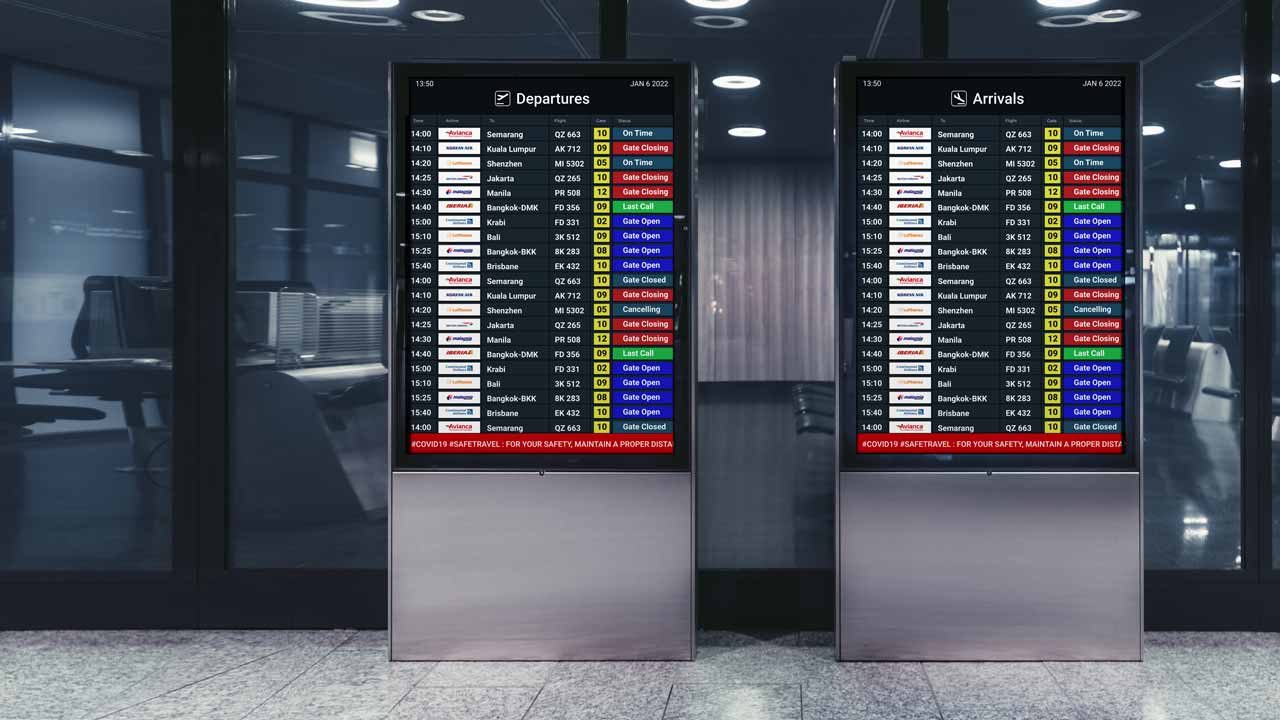Airports and transportation hubs are busy places that require effective and efficient planning, organizing, and communicating to handle the large number of people that transit through them each day. As the application of technology advances constantly, digital signage and touchscreens are essential equipment to enhance the service atmosphere in these centers. Today’s airports, bus stations, and train terminals are no exception to this shift, as transportation centers globally have adopted digital technology to improve passenger services, operations, and meeting the rising trends of a technology-driven society.
This blog aims at explaining the general aspects of why digital signage and touchscreens have become an essential component in airports and transportation centers, how they enhance customer experience, and other advantages for users and owners.
1. Efficient Communication and Real-time Information
Perhaps one of the most significant requirements of any transport center is the provision of information dissemination to the consumers. Previously, these included loudspeaker and bulletin boards, but these channels were rarely as live and coherent as they should be to support operations. This problem is solved by digital signage and touch screens in that it provides customers with information on its smart screens, including flight numbers, train schedules, boarding times, delays, and gate changes.
If a transportation hub is connected to the digital network, it can immediately change the messages on hundreds of screens located in its premises thus keeping the passengers informed. Integration with airline and train databases is in real-time, thus providing only up to date information and minimizing the confusion that always results from disruptions. In addition, it is possible to change messages dynamically in different languages hence helping the travelers in other countries to understand what is being passed across.
For instance, in large international airports, electronic signs at the terminals and gates show not only flight schedules and statuses but also directions to security screening, baggage claim, and other places of interest. Interactive touch screens mounted on kiosk displays this information and makes it easier for passengers to navigate and make a right decision within a shorter time.
2. Enhanced Passenger Experience and Wayfinding
Major transport terminals are always difficult to manage especially for the first time or for those passengers who have a short connecting time. Terminals, gates or platforms for airport and train stations are commonly multi-story buildings with multiple floors and often hundreds of gates or platforms. All in all, this can easily disorient the travelers and as a result cause confusion, delay and frustration.
The use of digital signage and touch screens offer an effective and easy to navigate system for people to use for directions. Screens located in the hub provide passengers with an option to enter their flight or destination and get the directions to the gate, baggage claim area or restaurants, restrooms, shops, etc. These touch screens may even contain maps, route showings and estimated walking time, making it easier and quicker to navigate.
Besides the navigational function, the digital sign improves the passengers’ experience with the content displayed. These displays can contain the current weather information, entertainment programs, news and even commercials. In some hubs they use screens to communicate certain flight safety information, which makes the travelers feel safe and comfortable during the flight. By addressing the content, the airport and train station can have a better approach to the kind of message to display which is based on time, flight schedule, and demography of passengers thus making it more personalized.
3. Operational Efficiency and Cost-effectiveness
For airport and transportation hub operators, one of the largest benefits to using digital signage is in the realm of operational effectiveness. Some of the applications include digitizing key data and connecting them to back-end systems that enable airports to cut on manual processes such as altering signs or controlling passenger movement during disruptions.
For instance, instead of having personnel to switch signs or to bring updates, the digital network does it. This insures that changes are made more quickly and with less likelihood of error than if it were performed manually by employees. In particular, this ability to instantly update passengers is beneficial during the high-traffic periods or when several flights are delayed because it allows avoiding overcrowding in some areas and ensuring a free movement throughout the terminal.
In the same respect, digital signage can also help airports and other transport facilities cut operating costs in the long run. Even though the setup cost for incorporation of digital systems is a little on the high side, they offset many of the recurrent expenses involved in the conventional signs such as printing and labor for the changes in static signs. Touchscreens and digital kiosks also eliminate the need for customer service personnel because the passengers can use the touch screens to look for information or even to perform a check-in or ticket purchase. In this case, transportation hubs are able to save money that will be used to attend to other important aspects of their business.
4. Safety and Security Enhancements
The security is always of utmost importance in airport and transportation related facilities since passenger and employees’ safety is of utmost important. Interactive and digital screens remain critical in increasing security because they offer easily understandable, real-time information, including emergencies. During an emergency, digital signage can instantly change from constant normal information to the one providing information on evacuation routes, exits and ways to protect oneself.
These systems can also interface with another surveillance system as well as aid the authorities in controlling crowds, detecting suspicious movements and directing people in the terminal away from any possible danger. Also, the strategic content of digital touch screens can be controlled to put up health and safety information which is essential nowadays due to Covid -19 and the likes. Messages encouraging people to follow social distances, wash their hands or wear masks have become a norm, while the use of touchless screens to avoid the spread of viruses is becoming more widespread.
5. Revenue Generation and Advertising Opportunities
Airports are also business places and contain shops, eateries, and waiting areas. Digital signages promote advertisements in a flexible way since it allows companies to convey their promotional messages to a large populace. In contrast to the posters that are printed and put on the bus stops, the ads online can be easily changed, and they can be updated at certain times, on certain dates and for certain groups of people.
For instance, information boards near doors can state the latest promotions of duty-free products, whereas the hoods in the food court can offer the latest promotions of restaurants in the same vicinity. This is a tool of high value for advertisers for it helps to catch the attention of the travelers who may have some spare time before their flight or train. Due to the high traffic of people, companies are willing to spend their money on digital advertisements and this can be a good source of revenue for airports and transport centers.
Additionally, touchscreens give possibilities for interactive advertisement. The use of ads allows passengers to interact with the product or service directly and can proceed to learn more about it, thus enhancing the chances of converting them. Users can enter values or inputs which allow retailers and service providers to target specific customers and provide them with offers or recommendations that can make them more satisfied, or would prompt them to purchase.
6. Environmental Sustainability
Environmental concerns are gradually emerging in the transport sector, and digital signage also support sustainability efforts. Airports and transportation centers can save a great deal of paper, which is traditionally used for maps, schedules, and brochures, owing to the use of such technologies. Also, current digital displays are more energy-friendly and many of the systems employed in their design contain smart features that lower the brightness of the screens during their idle time.
Through digital solutions, transportation hubs could affirm their sustainability policies, a rather relevant aspect in the passengers’ and companies’ world. Indeed, digital signage networks can also be used to convey the green activities to the passengers such as the need to use public transport, avoid using plastics or to participate in carbon neutral schemes.
Conclusion
Contemporary airports and transportation centers are required to be effective, flexible, and oriented to millions of users and passengers. This shift is led by digital signage and touchscreens as they help to transform the experience of passengers in transport stations or affect the general travel experience in one way or another.
These tools provide a variety of advantages to passengers and operators include real-time updates and improvements in wayfinding, operational efficiency and revenue generation. Moreover, they are indispensable in matters concerning safety and security as well as the case with environmental conservation. In recent years, there has been a significant growth of digital screens and touch screens in airports and other transportation centers; and with the advancement of technology in future, there is high possibilities to experience further changes in travel.





